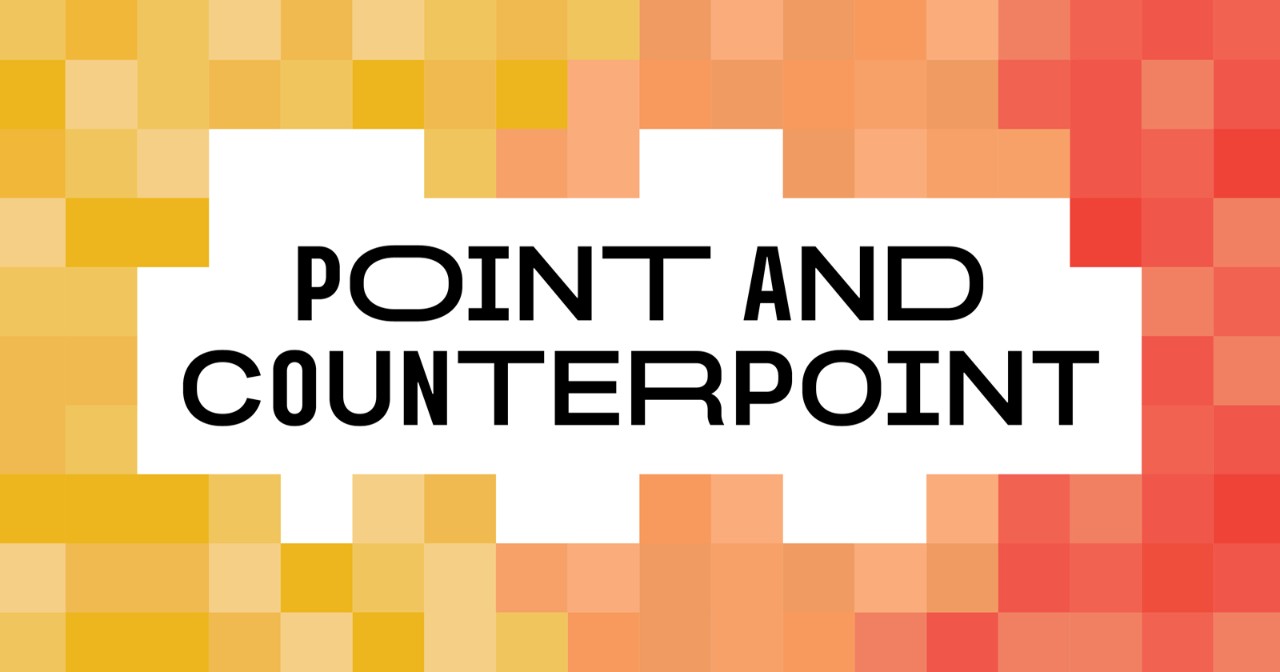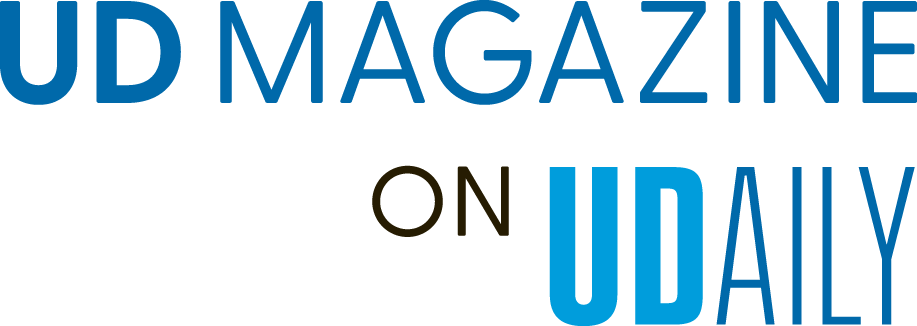


Hen vs. Hen
Blue Hens square off on AI
November 01, 2024
When it comes to AI, only code is binary. None of the most pressing issues are black and white, and Blue Hen experts are well versed in nuance.
But for the sake of debate (and what’s more topical than debating AI?), UD Magazine asked some of these experts to face off on contentious topics.
Here’s what they had to say about AI and...

Point/Counterpoint: Artificial Intelligence and Democracy: youtube.com/watch?v=4FjlxcHkk5o

Lindsay Hoffman, associate professor of communication and director of public engagement for the Center for Political Communication
While artificial intelligence does have deleterious impacts on a democracy, especially in a presidential election cycle, there is also hope for its application. These tools may lower the heat around contentious issues by helping citizens articulate ideas with non-combative language, fostering more civil dialogue. AI can distill a candidate’s platform or a policy's potential impacts, boosting citizen understanding of the issues and—potentially—voter turnout. And this technology is already assisting citizens with advocacy campaigns for a variety of causes, contributing to more robust civic engagement. On election day, AI could be used to streamline administrative processes, and it may be leveraged to identify voter fraud. In short, while there are concerns about AI for our democracy, we may find that these tools can lead to a newer, flourishing model of democracy.

Counterpoint:
Dannagal Young, professor of communication and political science; director of the Center for Political Communication; and author of Wrong: How Media, Politics, and Identity Drive our Appetite for Misinformation
Just before New Hampshire’s 2024 primary election, citizens received a phone message from a voice claiming to be that of President Biden, urging them to save their votes for November’s general election. Only it wasn’t Joe Biden—it was a deepfake, a piece of manipulated media content produced by artificial intelligence. AI is tailor made for the creation and dissemination of falsified ads, articles and websites that misrepresent reality and suppress voter turnout. We like to think that we will not be fooled by these tactics, but as human beings in a chaotic information environment, we are all vulnerable. Predictive AI models are excellent at... “predicting” and confirming what it is we want to believe. Resisting such propaganda requires that we think about our emotional responses to content—and who might stand to gain from them.


Joseph Nyangon, BSPA17PHD, deputy director of partnerships at the U.S. Department of Energy
Consider the Texas blackout of 2021. Or any of the smaller, daily energy-grid failures that don’t make the news. A changing climate is set to make this problem worse. But AI—which allows for more accurate, real-time monitoring—can help prevent such failures or equip us with solutions when they occur. AI can also help prioritize grid maintenance projects and better integrate renewable energy sources, reducing carbon emissions and optimizing electricity flow within a community or city. AI will improve the management of smart, energy-efficient buildings. In the future, AI may even help us develop entirely new power infrastructures that are more resilient to a changing climate. Yes, powering this technology will require a lot of energy, but the solution to increased power usage due to AI will come from—well—AI.

Counterpoint:
Saleem Ali, Blue and Gold Distinguished Professor of Energy and the Environment
Consider the Texas blackout of 2021. Artificial intelligence requires such an immense amount of energy that widespread adoption may lead to more large-scale grid failures. Already, 800 million people globally lack access to electricity. AI will cause a drastic expansion of computer server farms, centers that gobble up energy as they store and distribute data. We sometimes envision the internet as satellites communicating with one another, but server farms also rely on a huge network of fiber-optic cables along the ocean floor. These are made from materials and exotic metals around the world, the mining of which can release toxic silica dust into the air or cause acid mine drainage in watersheds. People often imagine a dystopian scenario in which computers take over humanity—but that’s far less concerning than AI’s environmental impact.


Alison Terndrup, visiting assistant professor in the Department of Art History
Artists understandably fear their work being scraped or plagiarized by AI tools, but there is no new idea under the sun—we all stand on the shoulders of giants. I think we’re going to see a lot more collaboration with AI, rather than reverting to this historical, Western-centric, not-quite-accurate notion of the genius—the Artiste with a capital “A”—an isolated person who spontaneously generates creative ideas from within. When it comes to AI art, if you dig deep enough, you will find the traces of humanity; now you can explore what pieces or words have come from man and which from machine—and whether you have a preference. Using AI as a mirror in this way, the journey is just beginning.

Counterpoint:
Katie Leech, assistant professor of art and design
Art produced by AI can be boring, vanilla, reductive. This is because AI tools rip off other artists—painters, writers, illustrators and designers who’ve not given consent. And they don’t rip them off equally. AI tools underrepresent certain races and genders, meaning we’re set to be inundated by the same ideas—the same voices—over and over. Especially for newer artists who haven’t wrestled with a blank canvas or page long enough to learn from their failures, AI tools contribute to the misconception that art and creativity should be immediate. They lessen tolerance for struggle, for taking time to evaluate what ideas are worth creating. Art is meant to serve as a mirror that reflects—and helps us understand—our place in the world. When that art is merely surface-level, society suffers.
Contact Us
Have a UDaily story idea?
Contact us at ocm@udel.edu
Members of the press
Contact us at 302-831-NEWS or visit the Media Relations website


